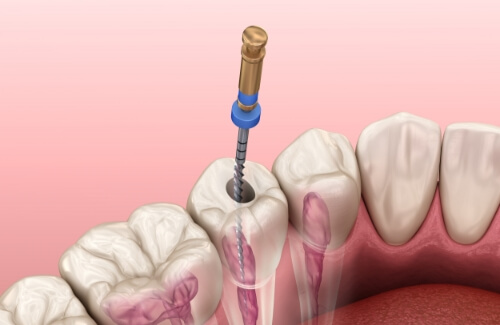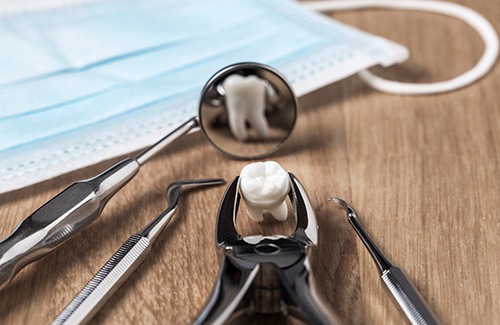Root Canal Treatment – Orem, UT
Putting a Stop to Tooth Pain

Far too many people avoid root canal treatment because they’re afraid that it will be painful. As a result, teeth that could have otherwise been saved end up needing to be removed. The truth of the matter is that root canal treatment can help stop the pain associated with infected teeth and allow you to keep your natural smile intact. Give Frandsen Dental of Orem a call to schedule an appointment so that we can figure out what steps are needed to help you find relief.
Why Choose Frandsen Dental of Orem for Root Canal Treatment?
- Lifelike Crowns for Restoring Treated Teeth
- State-of-the-Art Digital Imaging
- Team That Truly Cares
Do I Need Root Canal Treatment?

The best way to find out is by scheduling a consultation with Dr. Rich, our dedicated dentist. That way, he can learn more about the symptoms you’ve been experiencing as well as take X-rays and examine your teeth. Usually, root canal treatment is necessary when the tooth is damaged to the point where it hurts to bite down, there is dark discoloration present, the gums are bleeding, or persistent sensitivity is present.
The Root Canal Process

When you undergo a root canal treatment, our goal will be to remove the infection in your tooth in order to prevent further pain and damage. Your mouth will be numbed during the procedure, which helps keep your discomfort under control; several patients in the past have compared it to what they might experience when having a filling placed.
After the necessary preparatory steps have been taken, we will make a small opening in your tooth. Through said opening, we will carefully take out the infected pulp. We will also thoroughly clean out the inside of the tooth (including the various canals) in order to make sure that no infectious material has been left behind.
After the cleaning is complete, gutta-percha will be used to fill the tooth. You will eventually need to have a crown placed on the tooth that was treated in order to strengthen and protect it.
The Benefits of Getting a Root Canal

As we mentioned above, root canals often are spoken about poorly. However, the procedure is virtually painless thanks to modern techniques and powerful numbing agents. Plus, this emergency dentistry procedure can stop the infection in its tracks, preventing the tooth from needing to be extracted in the process. That combined with the fact that the restoration used to cover the tooth looks just like the real thing means this service benefits the look, health, and function of your smile.
Understanding the Cost of Root Canals

Now that you understand more about the process of getting a root canal in Orem, it’s natural to wonder how much the procedure usually costs. Our team at Frandsen Dental of Orem is happy to provide a detailed estimate once we’ve examined your mouth because the pricing depends on your unique situation.
Continue reading to learn more about considerations that impact your final invoice, and feel free to contact us for additional information!
Factors That Can Affect Root Canal Cost

Many patients ask for a quote for their root canal in advance, but we cannot know how much it will cost until we assess your condition. Several different factors can influence the total amount due, including:
- Other services. We usually provide a dental crown to shield your injured tooth, which has associated expenses. If we find issues requiring attention, you’ll also be responsible for any other treatments required.
- Where the damaged tooth is located. Your front teeth are easier to access and have fewer roots than your molars, so they usually don’t require as much time, effort, or supplies to treat.
- The severity of your condition. If your tooth is severely injured and a specialist is required, their fees will also be included.
Is it Cheaper to Pull My Tooth?

If you’re on a tight budget, you might wonder if there’s a more cost-effective alternative to treat your aching, decayed, or broken tooth. For instance, some people want to know whether removing it is better. While this option might seem cheaper initially, the truth is there are additional risks that can lead to further expenditures down the road.
For instance, your jawbone begins to deteriorate without a root to stimulate new bone growth when you bite down, weakening the foundation your remaining teeth need to remain firmly in place. Furthermore, you’re at an increased risk of developing gum disease or another infection at the extraction site. A root canal allows our team to preserve your natural tooth, which is usually better for your overall oral health.
Does Dental Insurance Cover Root Canal Treatment?

Many dental insurance policies cover a portion of major procedures like root canals. For instance, they often include 50% to 80% of the cost once your deductible has been met. However, there’s no guarantee and there might also be additional restrictions you should be aware of, like a waiting period that must pass before benefits kick in.
It’s worth checking with your plan to verify the details. Please let us know if you’re struggling to find the information or require assistance with claims or paperwork. Our friendly office staff is familiar with the process and is happy to help you maximize your available benefits.
Other Options for Making Root Canal Treatment Affordable

A root canal can be a smile-saving procedure, and we don’t want your finances to hold you back from receiving the quality care that you deserve. We gladly offer the following options to help make your treatment more affordable:
- In-house memberships. For a low annual or monthly fee, you gain access to basic preventative care and other discounted services without deductibles or waiting periods.
- Flexible financing. We’ve partnered with CareCredit to offer financial packages that allow you to break up your total invoice into smaller, more manageable monthly installments.
Root Canal Treatment FAQs
How Long Does It Take to Recover from a Root Canal?
Recovery time is different for each patient. However, most patients are able to return to their normal work or school schedule the day following their root canal. If you have a job that is physically demanding, you may want to take a couple of days off. This is because vigorous exercise can make the healing process take longer because the blood is diverted from the site. Your mouth will likely feel sore for a couple of days, so take over-the-counter pain relievers as directed. During this period, stick to soft foods and chew on the other side of your mouth. Brush and floss as normal but be especially careful around the tooth that has been treated.
Can I Eat Before a Root Canal?
This depends. If you are receiving sedation for your root canal treatment, you might be asked to fast for a couple of hours beforehand to reduce your risk of nausea. If you are only receiving a local anesthetic, it is recommended that you eat a healthy meal a couple of hours before your procedure. Since your mouth will be numbed for the procedure, it is best to wait until you regain feeling in your mouth before you eat again. It is a good idea to avoid alcohol for 24 hours before your procedure because it can react negatively with the local anesthetic.
How Long Does a Root Canal Take?
Root canal treatment can usually be completed in a single appointment. However, it can sometimes take two to prepare for the procedure. The root canal itself should take anywhere from 30 to 90 minutes depending on which tooth is affected and how many roots it has. Molars have more root canals that need to be disinfected, so they take longer to treat than teeth in the front of the mouth.
Are Root Canals Painful?
Back in the olden days, root canal treatment wasn’t a comfortable procedure. Fortunately, with modern dental techniques and technology, root canal treatment today doesn’t feel much different from getting a cavity filled. The pain that is often associated with root canal treatment stems from the toothache that warrants the procedure in the first place. Root canal treatment is designed to relieve this pain and save your tooth from being extracted. Before your procedure begins, we will numb the area with a local anesthetic so that you don’t feel a thing. If you are anxious about your procedure, or you have difficulty undergoing dental procedures for one reason or another, sedation options are also available for additional comfort.
